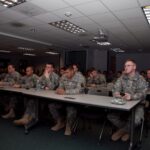Medical support is one of the key planning domains for operations. It helps preserve the health and fighting strength of the force. The Medical Protection System (MEDPROS) is an online tool that allows leaders to manage individual Soldier medical readiness. It checks things like immunizations, periodic health assessments, and dental and vision screenings. This gives leaders visibility into managing the health of their troops and, in turn, unit readiness.
MEDPROS is a vital part of the Army’s effort to ensure the force is medically ready for deployment. The goal is to minimize morbidity and mortality due to disease-nonbattle injury, which has historically accounted for more of the overall deployed force’s death toll than combat injuries. Leaders need to be vigilant in managing the physical and mental health of their units. They need to make sure they are keeping track of their soldiers’ MEDPROS status, and getting them in for their flight physicals, PHAs, and annual vision and hearing exams.
One of the long-term solutions is to create preventive medicine units with company-sized elements that comprise all of the force health protection assets and would fully supplant the PM detachment. Another is to create a joint force health protection command, which would align all forces with the same goals and allow for standardized training, faster communication of trends and solutions, and quicker implementation. This approach will also help to reduce duplications and redundancies, freeing up more time for deployment readiness initiatives.
Where is Army Medical Command?
Army medical Command (MEDCOM) is the primary Army organization for military health, medical training, and education. It also supervises medical research, development, and acquisition, and it provides leadership and direction for the Army’s health-related science and technology programs.
MEDCOM is headquartered at Fort Detrick, Maryland, and it has 8 subordinate commands worldwide. Its mission is “To Conserve Fighting Strength” by ensuring that the Army is physically and mentally healthy, equipped to fight in today’s wars, and ready for future challenges. MEDCOM is led by the Surgeon General of the United States Army, who is a lieutenant general.
In 1993, a series of mergers reshaped the AMEDD and created MEDCOM as a major command under the Surgeon General. The Army Medical Department Center and School (AMEDDC&S) became the headquarters arm of MEDCOM. In 1994, MEDCOM became fully operational and dropped the provisional designation. In 1996, the Medicate Field Service Schools (MFSS) were renamed Regional Medical Commands and given more authority.
In 2009, the U.S. Army Public Health Command (USAPHC) was established as a core public health command for the Army, merging missions from the previous Army Center for Health Promotion and Preventive Medicine (CHPPM) and the U.S. Army Veterinary Command (VETCOM). USAPHC is an integral part of the broader U.S. Army MEDCOM structure and contributes to its transformation from an illness-based system to one focused on prevention.

What are the Categories of Medpros?
MEDPROS doesn’t categorize soldiers in the traditional sense. Instead, it focuses on a soldier’s medical readiness through six key areas, often referred to as PULHES:
- Physical Functional Capacity
- Upper Extremities
- Lower Extremities
- Hearing and Ears
- Eyes and Vision
- Sychiatric
Each category in PULHES has a rating system (1-4) that determines a soldier’s deployability:
- 1: Meets all requirements for that category (fully deployable)
- 2: Deficiency exists but can be corrected within 72 hours (potentially deployable)
- 3: Deficiency requires more than 30 days to correct (may not be deployable)
- 4: Soldier’s status in that category is unknown (deployability unclear)
